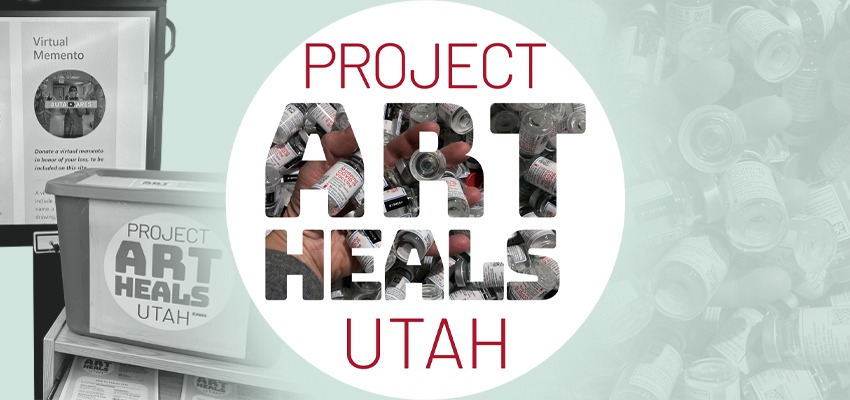
By Sarah Buening, Sustainable Campus Initiative Fund Intern
The COVID-19 vaccine marked a turning point in the pandemic and offered a glimmer of hope for many people, including University of Utah anesthesiologist Dr. Emily Hagn. Exhausted by the collective loss and continuous struggle of COVID-19, Hagn decided to keep her vaccine vial as a hopeful memento. But this first symbolic gesture soon turned into something much larger: an opportunity to honor community, patients, healthcare workers, and science through art.
In the uncertain back and forth of life in a pandemic, Hagn recognized the need for an emotional symbol of hope on the U’s campus. With support from the Sustainable Campus Initiative Fund (SCIF), she launched Project Art Heals Utah—a collaborative mosaic art project that uses empty COVID-19 vaccine vials, clean healthcare waste from University of Utah patient care areas, and other donated mementos—to commemorate all that we have lost to the pandemic.
Something special about this project is its creative use of waste. The World Health Organization reported that the hundreds of thousands of pounds of COVID-19-induced waste expose a dire need to improve waste management systems everywhere. Instead of contributing further to this accumulation of trash, Project Art Heals Utah channels waste into art that is both emotionally evocative and ecologically sustainable.
Project Art Heals Utah also provides a much-needed outlet to facilitate community healing. Among other things, we’ve lost loved ones, endured isolation, and missed out on some of life’s most special moments. Getting to this point has demanded resiliency, and that alone is worth commemorating. “Art is emotion,” says the project’s artist Heidi Calega. She wants this piece to serve as a reminder, not only of how quickly life can be upended, but also of how people “pivot, adapt, and carry on with a ‘new normal.’”
Calega, who lost her father to melanoma during the pandemic and was unable to say her final goodbyes, experienced bouts of depression in the months that followed. “The one thing that calmed my hands and heart was creating art,” she says. Through art, she reflected on how much her father had taught her and reconciled with the reality of the pain he had suffered. Project Art Heals Utah helped Calega find closure, and she hopes it will do the same for others.
“Through creativity and imagination, we find our identity and our reservoir of healing,” write Heather L. Stuckey and Jeremy Nobel (2010). Mementos from those who have passed memorialize loss in a meaningful way and can serve as a reminder of our history and collective memory.
Keep an eye out for the final art piece, which will find its home in campus clinics and libraries. It will depict three individuals jumping powerfully, the negative space inhabited by empty COVID-19 vaccine vials and the figures made from medical waste and public donations. The mosaic will stand as a tribute, reclaimed from the broken bits of our shattered past.
Monuments matter, and they can help us reflect on everything that has made us who we are.
References:
Stuckey, H. L., & Nobel, J. B. (2010). The Connection Between Art, Healing, and Public Health: A Review of Current Literature. Am J Public Health, 100(2), pp. 254-263.
